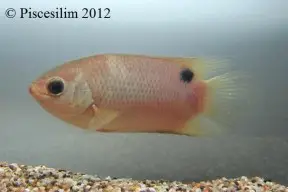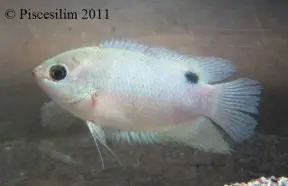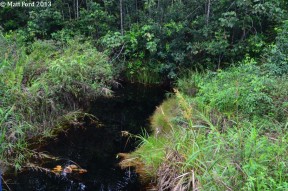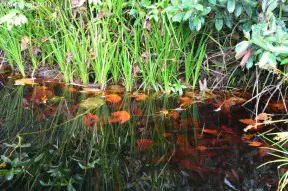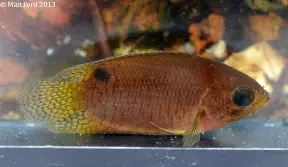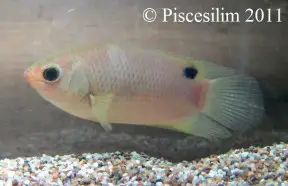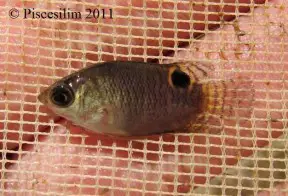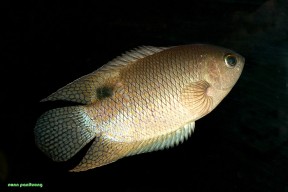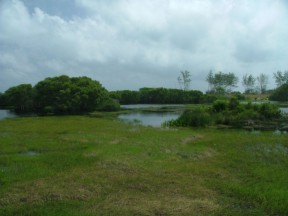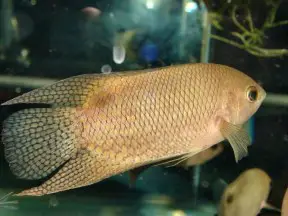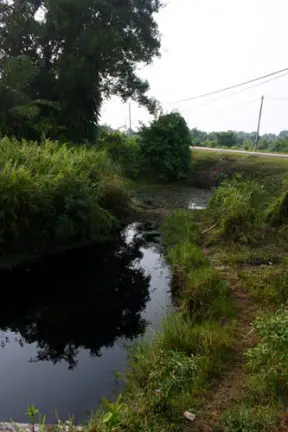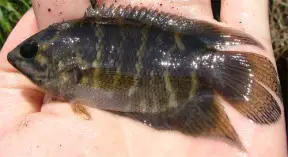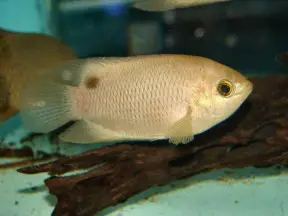Belontia hasselti
Java Combtail
SynonymsTop ↑
Polyacanthus hasselti Cuvier, 1831; Polyacanthus enthovenii Bleeker, 1851; Polyacanthus kuhlii Bleeker, 1845; Polyacanthus helfrichii Bleeker, 1855
Etymology
Belontia: from a vernacular Bornean word for an unspecified, similar-looking species.
hasselti: named for Dutch zoologist Johan Coenraad van Hasselt (1797-1823).
Classification
Order: Perciformes Family: Osphronemidae
Distribution
Native to southern Indochina, from southern (peninsular) Thailand, throughout Peninsular Malaysia, Singapore, and the Greater Sunda Islands of Sumatra, Borneo, and Java. It is possibly absent from northern Borneo.
Type locality is ‘Java, Indonesia’.
Habitat
Mostly occurs in acidic freshwater biotopes with little water movement, particularly ancient forest peat swamps in which the water that is stained dark brown by humic acids and other chemicals released from decaying organic material.
This results in a negligible dissolved mineral content and pH values may be as low as 3.0-4.0. The dense rainforest canopy above means that very little light penetrates the water surface, and the substrate normally littered with fallen tree branches and leaf litter.
Aquatic plant species may include representatives of genera such as Cryptocoryne, Blyxa, Barclaya, Eleocharis, Utricularia and Lymnophila.
Unfortunately vast tracts of primary forest have been altered or lost entirely due to logging, agriculture and other human activities throughout Southeast Asia, with fish habitats in affected regions also heavily-modified in many cases and species diversity declining.
A typical habitat of B. hasselti is the coastal heath forest at Rantau Abang, Terengganu state, Peninsular Malaysia which consists of small water channels flowing slowly through stands of vegetation composed mostly of a Melaleuca species (myrtle). The substrate was a mixture of sand and peat and the water acidic (pH 4.5 in February 2009).
Fish diversity was high with sympatric species including Boraras maculatus, Brevibora cheeya, Cyclocheilichthys apogon, Osteochilus spilurus, Parachela maculicauda, P. oxygastroides, Rasbora einthovenii, R. trilineata, Desmopuntius johorensis, Trigonopoma gracile, T. pauciperforatum, Lepidocephalichthys furcatus, Pangio alcoides, P. semicincta, Kryptopterus macrocephalus, Ompok leiacanthus, Wallago leerii, Hemibagrus nemurus, Pseudomystus leiacanthus, Clarias batrachus, C. meladerma, Parakysis verrucosa, Aplocheilus panchax, Hemirhamphodon pogonognathus, Monopterus albus, Nandus nebulosus, Pristolepis grooti, Betta imbellis, B. waseri, Luciocephalus pulcher, Parosphromenus paludicola, Trichopodus leerii, T. trichopterus, Trichopsis vittata, Channa bankanensis, C. lucius and C. striata.
Maximum Standard Length
150 – 200 mm.
Aquarium SizeTop ↑
An aquarium for a single pair should have base dimensions of 120 ∗ 30 cm or more.
Maintenance
Provided adequate cover and structure is available this species is unfussy with regards to décor with ceramic flowerpots, lengths of plastic piping and other artificial materials all useful additions. A more natural-looking arrangement might consist of a soft, sandy substrate with wood roots and branches placed such a way that plenty of shady spots and caves are formed.
The addition of dried leaf litter (beech, oak or Ketapang almond leaves are all suitable) would further emphasise the natural feel and with it the growth of beneficial microbe colonies as decomposition occurs. These can provide a valuable secondary food source for fry, whilst the tannins and other chemicals released by the decaying leaves will aid in the simulation of a blackwater environment. Alder cones may also be used for the latter purpose. There is no need to use natural peat, the collection of which is both unsustainable and environmentally-destructive.
Fairly dim lighting is recommended and plant species from genera such as Microsorum, Taxiphyllum, Cryptocoryne and Anubias are best since they will grow under such conditions. A few patches of floating vegetation to diffuse the light even further may also prove effective.
Since this species naturally inhabits sluggish or still environments therefore filtration, or at least water flow, should not be very strong. Very large water changes are best avoided with 10-15% weekly adequate provided the tank is lightly-stocked.
Water Conditions
Temperature: 21 – 26 °C
pH: 4.5 – 8.5
Hardness: 18 – 447 ppm
Diet
Primarily carnivorous and apparently feeds onb invertebrates, molluscs, and small fishes in nature.
In the aquarium larger live and frozen foods such as earthworms or shellfish are taken and most specimens will also learn to accept dried alternatives, with pelleted products generally preferred to flake. Smaller food stuffs such as chironomid larvae (bloodworm) or Artemia are accepted by smaller specimens but may be ignored by adults.
Behaviour and CompatibilityTop ↑
Not recommended for the average community aquarium but can be maintained alongside other fishes in larger set-ups. Very small fishes are best avoided as they may be eaten, but peaceful, medium-sized schooling cyprinids are suitable as are other robust anabantoids from genera such as Trichopodus or Helostoma.
Belontia species are not gregarious except when juvenile with males generally aggressive towards conspecifics including non-spawning females. Particular care should be exercised when introducing new specimens to an existing individual or group as they may even be killed. Unless your tank is very large keeping just a single sexed pair is therefore the recommended option.
Sexual Dimorphism
Fully-grown males are noticeably larger and possess more elongate unpaired fins than females, but juveniles cannot be sexed accurately by external means.
Reproduction
Paternal bubble nester and apparently very fecund, but we have been unable to obtain precise details to date.
NotesTop ↑
This species is also referred to by the vernacular name ‘Malay combtail’.
In terms of external characters it differs most obviously from its only congener, B. signata by its overal brownish grey (vs. reddish) body colouration, and presence (vs. absence) of a mosaic-type pattern in the unpaired fins.
The position of relatedness of the genus Belontia with respect to other anabantoids remains somewhat unresolved with neither morphological nor molecular evidence proving conclusive to date.
Britz (1995) suggested it may represent the sister group to all other members of the family Osphronemidae based on the fact that the second external levator muscle of the second gill arch is unmodified (as in Helostoma and the family Anabantidae), whereas in other osphronemids it is modified into a thin layer covering the entire posterior part of the suprabranchial chamber.
However in the molecular phylogeny of Rüber et al. (2006) Belontia was found to be most closely-related to the ‘giant gouramis’ of the genus Osphronemus, although basal relationships among osphronemids were not recovered.
Like other taxa in the suborder Anabantoidei this species possesses an accessory breathing organ known as the labyrinth, which permits the fish to breathe atmospheric air to a certain extent. Comprising paired suprabranchial organs formed via expansion of the epibranchial (upper) section of the first gill arch and housed in a chamber above the gills, it contains many highly-vascularised, folded flaps of skin which function as a large respiratory surface. Its structure varies in complexity between species, tending to be more developed in those inhabiting harsher environments.
References
- Cuvier, G. and A. Valenciennes., 1831 - Histoire naturelle des poissons. v. 7: 1-531
Histoire naturelle des poissons. Tome septième. Livre septième. Des Squamipennes. Livre huitième. Des poissons à pharyngiens labyrinthiformes. - Kottelat, M., 2013 - Raffles Bulletin of Zoology Supplement 27: 1-663
The fishes of the inland waters of southeast Asia: a catalogue and core bibiography of the fishes known to occur in freshwaters, mangroves and estuaries. - Kottelat, M. and E. Widjanarti, 2005 - Raffles Bulletin of Zoology Supplement 13: 139-173
The fishes of Danau Sentarum National Park and the Kapuas Lakes area, Kalimantan Barat, Indonesia. - Linke, H., 1992 - Tetra Press: 176 pp.
Labyrinth Fish: The Bubble Nest Builders. - Roberts, T. R. , 1989 - Memoirs of the California Academy of Sciences 14: 1-210
The freshwater fishes of western Borneo (Kalimantan Barat, Indonesia). - Rüber, L, R. Britz and R. Zardoya, 2006 - Systematic Biology 55(3): 374-397
Molecular phylogenetics and evolutionary diversification of labyrinth fishes (Perciformes: Anabantoidei). - Tan, H. H. and P. K. L. Ng, 2005 - Raffles Bulletin of Zoology Supplement 13: 115-138
The labyrinth fishes (Teleostei: Anabantoidei, Channoidei) of Sumatra, Indonesia.

